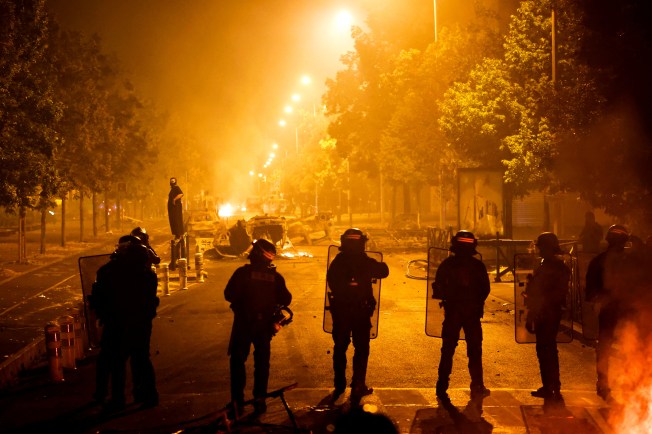Violent protests have spread across France and Belgium following the fatal shooting of a 17-old teenager by police during a traffic stop in the Paris suburb of Nanterre on Tuesday, June 27. Skirmishes between police and protestors have been reported in cities including Lille, Toulouse, Marseille, Lyon, Pau, Montpellier, and the Belgian capital of Brussels. Hundreds have been arrested following looting, vandalization of cars and buildings, and attacks on the police with fireworks and projectiles.
With protests expected to continue in coming days, HP Risk Management, a security consultancy that has supported media during previous French protests, warns that journalists covering them could face risks from police, demonstrators, and criminals. CPJ documented police obstruction, detention, and harassment of journalists covering protests against changes to the country’s pension law earlier this year and reporters were abused and assaulted by protesters during protests in 2018 and 2022.
“Journalists are attractive targets during these periods of social disorder,” says HP Risk Management’s David Holley. “Media have had vehicles broken into and equipment stolen, so a low profile and carrying of only essential equipment and valuables is a wise precaution.”
Journalists can minimize these risks by following CPJ’s guidance below.
Be prepared:
- Plan the assignment and ensure that you have a full battery on your cell phone. Know the area you are going to. Work out in advance what to do in an emergency. See the short CPJ video on how to prepare for covering a protest assignment.
- Always try to work with a colleague and have a regular check-in procedure with your base–particularly if covering rallies or crowded events.
- Wear clothing and footwear that allow you to move swiftly. Avoid wearing necklaces, ponytails, lanyards, or anything that can be grabbed, as well as flammable material, such as nylon.
- Do not carry valuables and if leaving a vehicle ensure it is parked in a secure location with no visible equipment on display.
- Consider your position. Try to find an elevated position that may offer greater safety.
- At any location, always plan an evacuation route. If working with others, select an emergency rendezvous point.
- Maintain situational awareness at all times and limit valuables in your possession. Do not leave any equipment in vehicles. After dark, the risk of criminal actions increases.
- If working in a crowd, plan a strategy. Try to keep to the outside of the crowd and avoid the middle, where it is hard to escape. Identify an escape route.
In situations where teargas may be used:
- Wear personal protective equipment, including a gas mask, eye protection, body armor, and helmet.
- Contact lenses are not advisable.
- Individuals with asthma or respiratory issues should avoid areas where teargas is being used. When large amounts of teargas are used, there is the possibility of high concentrations of gas sitting in areas with no movement of air.
- Take note of landmarks (i.e. posts, curbs) that can be used to help you navigate out of an area if you are struggling to see.
- If you are exposed to teargas, try to find higher ground and stand in fresh air to allow the breeze to carry away the gas. Do not rub your eyes or face. When you are able, shower in cold water to wash the gas from your skin, but do not bathe. Clothing may need to be washed several times to remove the crystals completely, or discarded.
- See CPJ’s video on preparing for assignments where teargas may be used.
When dealing with aggression:
- Read body language and use your own body language to pacify a situation.
- Keep eye contact with an aggressor, use open hand gestures and keep talking with a calming manner.
- Keep an extended arm’s length from the threat. Back away and if someone grabs hold of you, break away firmly without aggression. If cornered and in danger, shout.
- If the situation escalates, keep a hand free to protect your head and move with short, deliberate steps to avoid falling. If in a team, stick together and link arms.
- Be aware of the situation and your own safety. While there are times when documenting aggression can be newsworthy, taking pictures of aggressive individuals can escalate a situation.
- See the CPJ video on how best to respond when a protest situation escalates.
Journalists requiring assistance can contact CPJ via emergencies@cpj.org.
CPJ Emergencies has additional information on basic preparedness, assessing and responding to risk, or safety measures when covering civil conflict and disturbances. Journalists can find more of CPJ’s safety information here.
